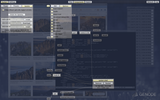Sculpt OS version 25.10
(published in October 2025)
Sculpt is an open-source general-purpose OS. It combines Genode's microkernel architecture, capability-based security, sandboxed device drivers, and virtual machines in a novel operating system for commodity PC hardware and the PinePhone. Sculpt is used as day-to-day OS by the Genode developers.
The administrative user interface ("Leitzentrale"): The panel at the top gives access to a live view of the system structure (shown), a file browser, network connectivity, power control, and system update/rollback. The interactive graph at the center presents the running components with their relationships and allows the user to interactively add/remove components offered by Genode Labs and federated software providers.
- Instructions
- Download disk image
-
sculpt-25-10.img (35 MiB) (signature, public key)
SHA256 0530fe9b464e717c1b6114d57893783c00946f3fe53a18721b5560ae1fd247ad
Evaluating the use of the human-readable data format (HRD)
The official version linked above readily accepts the new proposed human-readable configuration format in addition to the time-tested use of XML while relying on XML by default.
To evaluate the new format, a Sculpt OS variant using the new format by default is provided at https://depot.genode.org/nfeske/image/.
Please consider the evaluation image as experimental.
- Download disk image using human-readable data by default
-
sculpt-pc-2025-11-21.img.xz (signature, public key)
SHA256 98d21f1e8eef9c157f34476476a3c44bd9b96c28ee25c4fd32935e4d489af345
This variant is also available via Sculpt's system-update dialog by installing version 2025-11-21 provided by nfeske. Both variants the one offered by genodelabs and the one offered by nfeske are largely interoperable. So one can switch between both variants by repeatedly (re-)installing the desired version in the system-update dialog.
Mobile-OS version
An experimental phone variant of Sculpt OS tailored for the PinePhone is available at https://depot.genode.org/genodelabs/image. Information about installing and using this variant are available in the form of a dedicated article at https://genodians.org.
MNT-Reform version
Sculpt OS is available for the i.MX8 variant for the MNT Reform laptop at https://depot.genode.org/skalk/image/ and at the system-update dialog when selecting skalk as provider.
- Download disk image for the MNT-Reform laptop
-
sculpt-mnt_reform2-2025-11-21.img.xz (signature, public key)
SHA256 faa56d41be6d2ec97d3811b74ae645dea43c708626c81f904add3dd07733a61e
Preparing a bootable USB stick on Unix
On Unix-based systems, use the dd command to copy the disk image to a USB stick:
sudo dd if=sculpt-25-10.img of=/dev/sdx bs=1M conv=fsync
Here, /dev/sdx refers to the device node of your USB stick. To determine it, you may inspect the output of dmesg after plugging it in.
Preparing a bootable USB stick on MS Windows
- Option 1: Rufus
-
-
Download and run Rufus (alternative portable executable available)
-
Plug in your USB thumb drive and select it under "Device"
-
Download the Sculpt OS image linked above and select it under "Boot selection"
-
Write to the USB drive by clicking "START"
-
- Option 2: Win32 Disk Imager
-
-
Download, install, and run Win32 Disk Imager
-
Download the Sculpt OS image linked above and select under "Image file"
-
Plug in your USB thumb drive and select it under "Device"
-
Write to the USB drive by clicking "Write"
-
Running Sculpt 25.10 in Qemu
You may take the following command line as starting point for experimenting with Sculpt 25.10 on the Qemu emulator.
qemu-system-x86_64 -display sdl -cpu Skylake-Client -machine q35 \
-m 1024 -drive format=raw,file=sculpt-25-10.img \
-netdev user,id=net0 -device e1000,netdev=net0
For better performance, you may also try the options -accel kvm -cpu host.
Previous versions
All previous releases are available at the dedicated Sculpt OS archive page.

